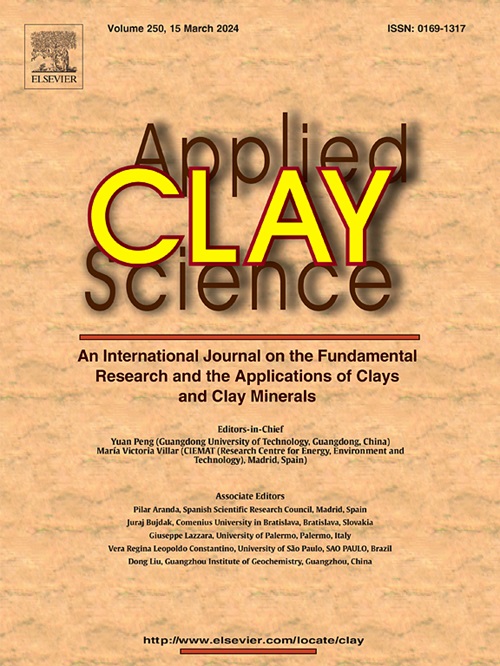Effects of elevated temperature on Wyoming bentonite and its implications for sorption of radioactive strontium
IF 5.3
2区 地球科学
Q2 CHEMISTRY, PHYSICAL
引用次数: 0
Abstract
Bentonite is a key barrier material in deep geological facilities for spent nuclear fuel, where it may be exposed to temperatures >100 °C because of radiogenic heating. Understanding how prolonged heating affects its physicochemical properties and radionuclide retention capacity is critical for ensuring long-term repository safety. This study investigated the impacts of dry heating (unconfined, evaporation allowed) at 150 °C for 36 months on the mineralogical and geochemical stability of a Wyoming bentonite, chosen for the Finnish geological disposal facility, and its subsequent sorption behavior with 90Sr. Although the bentonite mineralogy remained mostly stable, combined X-ray diffraction, cation exchange capacity, titrations, demonstrated partial Na to Ca exchange within montmorillonite's interlayer following heating, and specific surface area analyses revealed a > 50 % reduction in specific surface area (30 to 14 m2/g). Colloid stability tests revealed that bentonite colloids did not form under repository-relevant saline conditions (I = 0.2 M), and heat treatment did not significantly impact colloid formation in reduced ionic-strength systems. Sorption isotherms demonstrated that Sr sorption was strongly pH-dependent, increasing from ∼40 % at pH 8 to ∼90 % at pH 13, and heating slightly enhanced Sr retention at pH 8. Two-site protolysis non-electrostatic surface complexation and cation exchange modelling suggested that in unheated bentonite, Sr was bound via a combination of surface complexation (∼30 %) and cation exchange (∼70 %) at pH 8, while at pH 13, sorption shifted towards surface complexation. However, after heating, cation exchange dominated at both pH values. Extended X-ray absorption fine structure analysis confirmed outer-sphere Sr sorption at pH 8 and increasing inner-sphere complexation at pH 13. Together, these findings highlight that despite minor physicochemical alterations, bentonite retained its Sr sorption potential, supporting its continued suitability as a buffer material in the ONKALO® repository.
高温对怀俄明州膨润土的影响及其对放射性锶吸附的影响
膨润土是深层地质设施中用于乏核燃料的关键屏障材料,由于放射性加热,膨润土可能暴露在100°C的温度下。了解长时间加热如何影响其物理化学性质和放射性核素保留能力,对于确保储存库的长期安全至关重要。本研究研究了在150°C下干热(无限制,允许蒸发)36个月对芬兰地质处置设施选择的怀俄明州膨润土的矿物学和地球化学稳定性的影响,以及其随后对90Sr的吸附行为。虽然膨润土矿物学基本保持稳定,但结合x射线衍射,阳离子交换容量,滴定,表明加热后蒙脱土夹层内部分Na到Ca的交换,比表面积分析显示了一个>;比表面积减少50%(30至14平方米/克)。胶体稳定性测试表明,膨润土胶体在与储存库相关的盐水条件下(I = 0.2 M)不会形成,并且在降低离子强度的体系中,热处理不会显著影响胶体的形成。吸附等温线表明,Sr的吸附与pH有很强的相关性,从pH 8时的~ 40%增加到pH 13时的~ 90%,加热略微增强了pH 8时Sr的保留。非静电表面络合和阳离子交换模型表明,在未加热的膨润土中,pH为8时,Sr通过表面络合(~ 30%)和阳离子交换(~ 70%)结合,而在pH为13时,吸附转向表面络合。加热后,两种pH值下阳离子交换均占主导地位。扩展x射线吸收精细结构分析证实了pH值为8时外球对Sr的吸附,pH值为13时内球络合增加。总之,这些发现强调,尽管有轻微的物理化学变化,膨润土仍保留了其Sr吸附潜力,支持其在ONKALO®储存库中继续作为缓冲材料的适用性。
本文章由计算机程序翻译,如有差异,请以英文原文为准。
求助全文
约1分钟内获得全文
求助全文
来源期刊

Applied Clay Science
地学-矿物学
CiteScore
10.30
自引率
10.70%
发文量
289
审稿时长
39 days
期刊介绍:
Applied Clay Science aims to be an international journal attracting high quality scientific papers on clays and clay minerals, including research papers, reviews, and technical notes. The journal covers typical subjects of Fundamental and Applied Clay Science such as:
• Synthesis and purification
• Structural, crystallographic and mineralogical properties of clays and clay minerals
• Thermal properties of clays and clay minerals
• Physico-chemical properties including i) surface and interface properties; ii) thermodynamic properties; iii) mechanical properties
• Interaction with water, with polar and apolar molecules
• Colloidal properties and rheology
• Adsorption, Intercalation, Ionic exchange
• Genesis and deposits of clay minerals
• Geology and geochemistry of clays
• Modification of clays and clay minerals properties by thermal and physical treatments
• Modification by chemical treatments with organic and inorganic molecules(organoclays, pillared clays)
• Modification by biological microorganisms. etc...
 求助内容:
求助内容: 应助结果提醒方式:
应助结果提醒方式:


